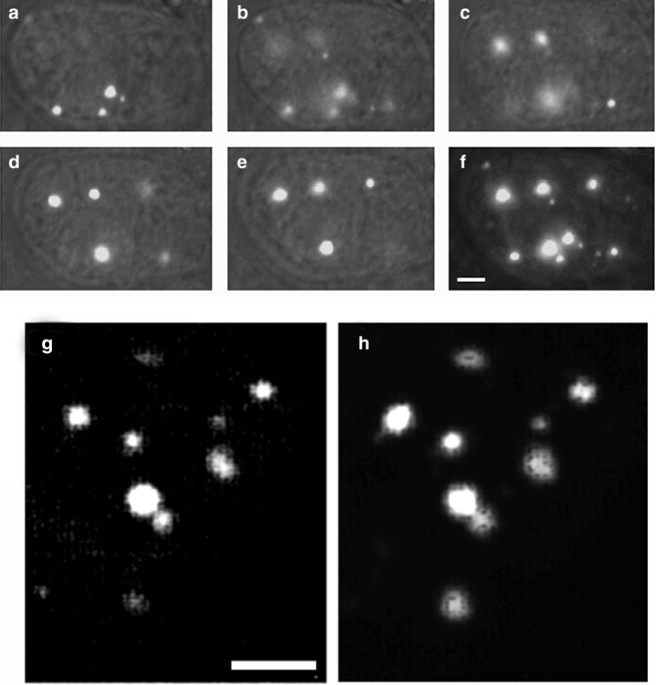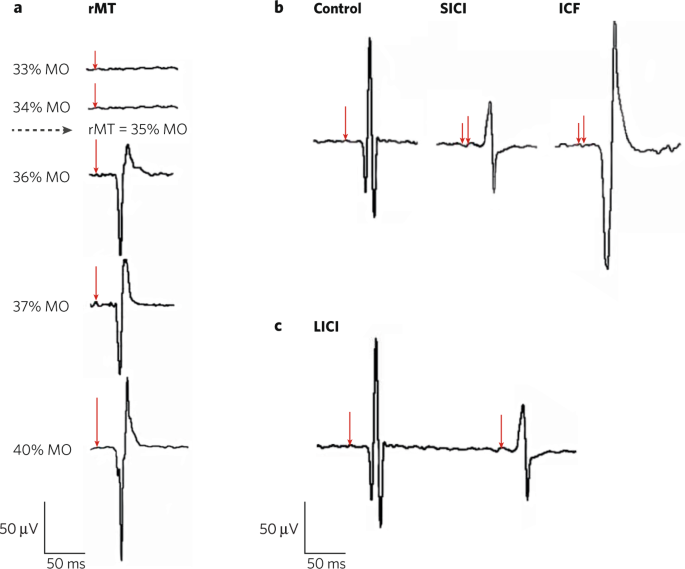
- Select a language for the TTS:
- UK English Female
- UK English Male
- US English Female
- US English Male
- Australian Female
- Australian Male
- Language selected: (auto detect) - EN
Play all audios:
ABSTRACT Chinese hamster cells have large interstitial (TTAGGG) bands (ITs) which are unstable and should be protected by an unknown mechanism. Here, we expressed in Chinese hamster V79
cells green fluorescent protein (GFP)-tagged human TRF1, and found that a major fraction of GFP-TRF1 bound to ITs is diffusionally mobile. This fraction strongly decreases after treatment of
cells with wortmannin, a protein kinase inhibitor, and this drug also increases the frequency of chromosome aberrations. Ionizing radiation does not induce detectable translocation of
GFP-TRF1 to the sites of random double-strand breaks visualized using antibodies against histone _γ_-H2AX. TRF1 is known to be eliminated from telomeres by overexpression of tankyrase 1
which induces TRF1 poly(ADP-ribosyl)ation. We transfected V79 cells by plasmid encoding tankyrase 1 and found that the frequency of chromosome rearrangements is increased in these cells
independently of their treatment by IR. Taken together, our results suggest that TRF1 is involved in sequence-specific protection of internal nontelomeric (TTAGGG)_n_ repeats. Access through
your institution Buy or subscribe This is a preview of subscription content, access via your institution ACCESS OPTIONS Access through your institution Subscribe to this journal Receive 50
print issues and online access $259.00 per year only $5.18 per issue Learn more Buy this article * Purchase on SpringerLink * Instant access to full article PDF Buy now Prices may be subject
to local taxes which are calculated during checkout ADDITIONAL ACCESS OPTIONS: * Log in * Learn about institutional subscriptions * Read our FAQs * Contact customer support SIMILAR CONTENT
BEING VIEWED BY OTHERS TELOMERE DAMAGE INDUCES INTERNAL LOOPS THAT GENERATE TELOMERIC CIRCLES Article Open access 20 October 2020 CHROMOSOME END PROTECTION BY RAP1-MEDIATED INHIBITION OF
DNA-PK Article Open access 16 April 2025 ZNF524 DIRECTLY INTERACTS WITH TELOMERIC DNA AND SUPPORTS TELOMERE INTEGRITY Article Open access 12 December 2023 ABBREVIATIONS * ATM: Ataxia
teleangiectasia-mutated protein * CA: chromosome aberration * DSB: double-strand DNA break * GFP: green fluorescent protein * IT: internal non-telomeric blocks of (TTAGGG)_n_ sequences *
NHEJ: nonhomologous end-joining REFERENCES * d'Adda di Fagagna F, Hande MP, Tong WM, Roth D, Lansdorp PM, Wang ZQ and Jackson SP . (2001). _Curr. Biol._, 11, 1192–1196. * Allen C,
Kurimasa A, Brenneman MA, Chen DJ and Nickoloff JA . (2002). _Proc. Natl. Acad. Sci. USA_, 99, 3758–3763. * Allio I and Preston RJ . (2000). _Mutat. Res._, 453, 5–15. * Alvarez L, Evans JW,
Wilks R, Lucas JN, Brown JM and Giaccia AJ . (1993). _Genes Chromosom. Cancer_, 8, 8–14. * Azzalin CM, Nergadze SG and Giulotto E . (2001). _Chromosoma_, 110, 75–82. * Bailey SM, Meyne J,
Chen DJ, Kurimasa A, Li GC, Lehnert BE and Goodwin EH . (1999). _Proc. Natl. Acad. Sci. USA_, 96, 14899–14904. * Baumann P and Cech TR . (2001). _Science_, 292, 1171–1175. * Bertoni L,
Attolini C, Faravelli M, Simi S and Giulotto E . (1996). _Mamm. Genome_, 7, 853–855. * Boulton S, Kyle S, Yalcintepe L and Durkacz BW . (1996). _Carcinogenesis_, 17, 2285–2290. * Burma S,
Chen BP, Murphy M, Kurimasa A and Chen DJ . (2001). _J. Biol. Chem._, 276, 42462–42467. * Chernikova SB, Wells RL and Elkind MM . (1999). _Radiat. Res._, 151, 159–166. * Chong L, van
Steensel B, Broccoli D, Erdjument-Bromage H, Hanish J, Tempst P and de Lange T . (1995). _Science_, 270, 1663–1667. * Cortez D, Wang Y, Qin J and Elledge SJ . (1999). _Science_, 286,
1162–1166. * Cost GJ and Boeke JD . (1998). _Biochemistry_, 37, 18081–18093. * Cost GJ, Golding A, Schlissel MS and Boeke JD . (2001). _Nucleic Acids Res._, 29, 573–577. * Day JP, Limoli CL
and Morgan WF . (1998). _Carcinogenesis_, 19, 259–265. * de Lange T . (2002). _Oncogene_, 21, 532–540. * Faravelli M, Azzalin CM, Bertoni L, Chernova O, Attolini C, Mondello C and Giulotto E
. (2002). _Gene_, 283, 11–16. * Ferguson DO and Alt FW . (2001). _Oncogene_, 20, 5572–5579. * Fernandez JL, Gosalvez J and Goyanes V . (1995). _Chromosome Res._, 3, 281–284. * Fernandez JL,
Goyanes VJ, Ramiro-Diaz J and Gosalvez J . (1998). _Cytogenet. Cell Genet._, 82, 195–198. * Flint J, Craddock CF, Villegas A, Bentley DP, Williams HJ, Galanello R, Cao A, Wood WG, Ayyub H
and Higgs DR . (1994). _Am. J. Hum. Genet._, 55, 505–512. * Gatei M, Young D, Cerosaletti KM, Desai-Mehta A, Spring K, Kozlov S, Lavin MF, Gatti RA, Concannon P and Khanna K . (2000). _Nat.
Genet._, 25, 115–119. * Gilley D, Tanaka H, Hande MP, Kurimasa A, Li GC, Oshimura M and Chen DJ . (2001). _Proc. Natl. Acad. Sci. USA_, 98, 15084–15088. * Gineitis AA, Zalenskaya IA, Yau PM,
Bradbury EM and Zalensky AO . (2000). _J. Cell Biol._, 151, 1591–1598. * Goytisolo FA and Blasco MA . (2002). _Oncogene_, 21, 584–591. * Griffith J, Bianchi A and de Lange T . (1998). _J.
Mol. Biol._, 278, 79–88. * Hande MP, Balajee AS, Tchirkov A, Wynshaw-Boris A and Lansdorp PM . (2001). _Hum. Mol. Genet._, 10, 519–528. * Hsu HL, Gilley D, Blackburn EH and Chen DJ . (1999).
_Proc. Natl. Acad. Sci. USA_, 96, 12454–12458. * Hsu HL, Gilley D, Galande SA, Hande MP, Allen B, Kim SH, Li GC, Campisi J, Kohwi-Shigematsu T and Chen DJ . (2000). _Genes Dev._, 14,
2807–2812. * Jeggo PA, Carr AM and Lehmann AR . (1998). _Trends Genet._, 14, 312–326. * Jurka J . (1997). _Proc. Natl. Acad. Sci. USA_, 94, 1872–1877. * Kilburn AE, Shea MJ, Sargent RG and
Wilson JH . (2001). _Mol. Cell. Biol._, 21, 126–135. * Kim SH, Kaminker P and Campisi J . (1999). _Nat. Genet._, 23, 405–412. * Kishi S and Lu KP . (2002). _J. Biol. Chem._, 277, 7420–7429.
* Kishi S, Zhou XZ, Ziv Y, Khoo C, Hill DE, Shiloh Y and Lu KP . (2001). _J. Biol. Chem._, 276, 29282–20991. * Krutilina RI, Oei S, Buchlow G, Yau PM, Zalensky AO, Zalenskaya IA, Bradbury EM
and Tomilin NV . (2001). _Biochem. Biophys. Res. Commun._, 280, 471–475. * Lippincott-Schwartz J, Snapp E and Kenworthy A . (2001). _Nat. Rev. Mol. Cell. Biol._, 2, 444–456. * Meyne J,
Baker RJ, Hobart HH, Hsu TC, Ryder OA, Ward OG, Wiley JE, Wurster-Hill DH, Yates TL and Moyzis RK . (1990). _Chromosoma_, 99, 3–10. * Misteli T, Gunjan A, Hock R, Bustin M and Brown DT .
(2000). _Nature_, 408, 877–881. * Morgan WF, Hartmann A, Limoli CL, Nagar S and Ponnaiya B . (2002). _Mutat. Res._, 504, 91–100. * Okabe J, Eguchi A, Masago A, Hayakawa T and Nakanishi M .
(2000). _Hum. Mol. Genet._, 9, 2639–2650. * Pandita TK . (2001). _Radiat. Res._, 156 (Part 2), 642–647. * Pandita TK . (2002). _Oncogene_, 21, 611–608. * Pandita TK and DeRubeis D . (1995).
_Cytogenet. Cell Genet_, 68, 95–101. * Pandita TK, Pathak S and Geard CR . (1995). _Cytogenet. Cell Genet._, 71, 86–93. * Radman M . (1991). _Biochimie_, 73, 357–361. * Rogakou EP, Boon C,
Redon C and Bonner WM . (1999). _J. Cell Biol._, 146, 905–916. * Samper E, Goytisolo FA, Slijepcevic P, van Buul PP and Blasco MA . (2000). _EMBO Rep._, 1, 244–252. * Sarkaria JN, Tibbetts
RS, Busby EC, Kennedy AP, Hill DE and Abraham RT . (1998). _Cancer Res._, 58, 4375–4382. * Sekiguchi J, Ferguson DO, Chen HT, Yang EM, Earle J, Frank K, Whitlow S, Gu Y, Xu Y, Nussenzweig A
and Alt FW . (2001). _Proc. Natl. Acad. Sci. USA_, 98, 3243–3248. * Shen M, Haggblom C, Vogt M, Hunter T and Lu KP . (1997). _Proc. Natl. Acad. Sci. USA_, 94, 13618–13623. * Simi S, Attolini
C and Giulotto E . (1998). _Mutat. Res._, 397, 229–233. * Slijepcevic P and Bryant PE . (1995). _Cytogenet. Cell Genet._, 69, 87–89. * Slijepcevic P, Xiao Y, Dominguez I and Natarajan AT .
(1996). _Chromosoma_, 104, 596–604. * Smilenov LB, Mellado W, Rao PH, Sawant SG, Umbricht CB, Sukumar S and Pandita TK . (1998). _Oncogene_, 17, 2137–2142. * Smith GP . (1976). _Science_,
191, 528–535. * Smith S, Giriat I, Schmitt A and de Lange T . (1998). _Science_, 282, 1484–1487. * Smith S and de Lange T . (2000). _Curr. Biol._, 10, 1299–1302. * Smogorzewska A, van
Steensel B, Bianchi A, Oelmann S, Schaefer MR, Schnapp G and de Lange T . (2000). _Mol. Cell. Biol._, 20, 1659–1668. * Song K, Jung D, Jung Y, Lee SG and Lee I . (2000). _FEBS Lett._, 481,
81–85. * Sprung CN, Reynolds GE, Jasin M and Murnane JP . (1999). _Proc. Natl. Acad. Sci. USA_, 96, 6781–6786. * Taylor AM, Metcalfe JA, Thick J and Mak YF . (1996). _Blood_, 87, 423–438. *
Tomilin NV, Solovjeva LV, Svetlova MP, Pleskach NM, Zalenskaya IA, Yau PM and Bradbury EM . (2001). _Radiat. Res._, 156, 347–354. * van Steensel B and de Lange T . (1997). _Nature_, 385,
740–743. * Yoshida M, Kijima M, Akita M and Beppu T . (1990). _J. Biol. Chem._, 265, 17174–17179. * Zalensky AO, Tomilin NV, Zalenskaya IA, Teplitz RL and Bradbury EM . (1997). _Exp. Cell
Res._, 232, 29–41. * Zhao S, Weng YC, Yuan SS, Lin YT, Hsu HC, Lin SC, Gerbino E, Song MH, Zdzienicka MZ, Gatti RA, Shay JW, Ziv Y, Shiloh Y and Lee EY . (2000). _Nature_, 405, 473–477. *
Zhong Z, Shiue L, Kaplan S and de Lange T . (1992). _Mol. Cell. Biol._, 12, 4834–4843. Download references ACKNOWLEDGEMENTS We thank S Smith for her kind gift of plasmids pTetFLNLS and
pUHR15-1. This research was supported by the Office of Science (BER), US Department of Energy, Grant No. DE-FG03-01ER63070, by the National Institutes of Health Grant No. 5R01-HD39830-02, by
the Deutsche Forschung Gemeinschaft Grant 436 RUS113/126/0, by the Civilian Research and Development Foundation Grant ST-012-0 and the Russian Fund for Basic Research Grants 01-04-49486 and
02-04-49145. AUTHOR INFORMATION AUTHORS AND AFFILIATIONS * Laboratory of Chromosome Stability, Institute of Cytology, Russian Academy of Sciences, 194064 St, Petersburg, Russia Raisa
Ivanovna Krutilina, Alexandra Nikolaevna Smirnova, Olga Stanislavovna Mudrak, Nadezhda Mikhailovna Pleskach, Maria Pavlovna Svetlova & Nikolai Viktorovich Tomilin * Institute of
Biochemistry, Free University of Berlin, Thielallee 63, Berlin-Dahlem, 14195, Germany Shiao-Li Oei * Department of Biological Chemistry, UC Davis School of Medicine, Davis, 95616, CA, USA
Peter M Yau, Edwin Morton Bradbury & Andrey Olegovich Zalensky * Bioscience Division, MSM 888, Los Alamos National Laboratory, Los Alamos, 87545, NM, USA Edwin Morton Bradbury Authors *
Raisa Ivanovna Krutilina View author publications You can also search for this author inPubMed Google Scholar * Alexandra Nikolaevna Smirnova View author publications You can also search for
this author inPubMed Google Scholar * Olga Stanislavovna Mudrak View author publications You can also search for this author inPubMed Google Scholar * Nadezhda Mikhailovna Pleskach View
author publications You can also search for this author inPubMed Google Scholar * Maria Pavlovna Svetlova View author publications You can also search for this author inPubMed Google Scholar
* Shiao-Li Oei View author publications You can also search for this author inPubMed Google Scholar * Peter M Yau View author publications You can also search for this author inPubMed
Google Scholar * Edwin Morton Bradbury View author publications You can also search for this author inPubMed Google Scholar * Andrey Olegovich Zalensky View author publications You can also
search for this author inPubMed Google Scholar * Nikolai Viktorovich Tomilin View author publications You can also search for this author inPubMed Google Scholar CORRESPONDING AUTHOR
Correspondence to Nikolai Viktorovich Tomilin. RIGHTS AND PERMISSIONS Reprints and permissions ABOUT THIS ARTICLE CITE THIS ARTICLE Krutilina, R., Smirnova, A., Mudrak, O. _et al._
Protection of internal (TTAGGG)_n_ repeats in Chinese hamster cells by telomeric protein TRF1. _Oncogene_ 22, 6690–6698 (2003). https://doi.org/10.1038/sj.onc.1206745 Download citation *
Received: 24 January 2003 * Revised: 29 April 2003 * Accepted: 30 April 2003 * Published: 02 October 2003 * Issue Date: 02 October 2003 * DOI: https://doi.org/10.1038/sj.onc.1206745 SHARE
THIS ARTICLE Anyone you share the following link with will be able to read this content: Get shareable link Sorry, a shareable link is not currently available for this article. Copy to
clipboard Provided by the Springer Nature SharedIt content-sharing initiative KEYWORDS * internal telomeric repeats * instability * TRF1 * wortmannin * tankyrase 1




